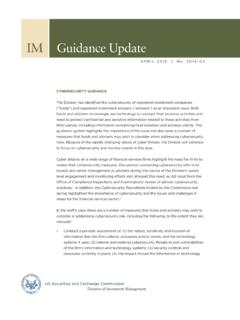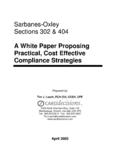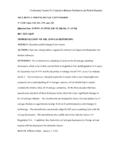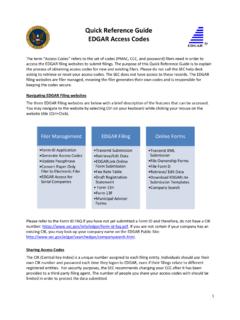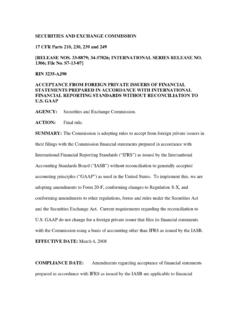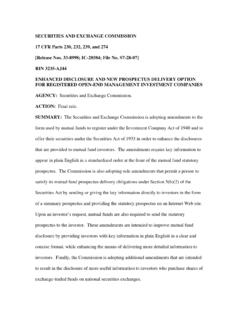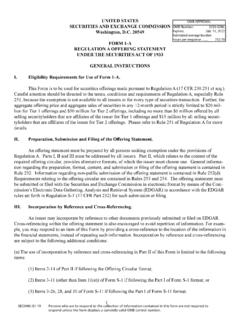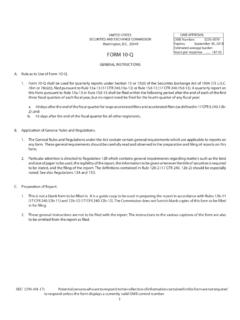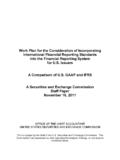Transcription of SECURITIES AND EXCHANGE COMMISSION 17 CFR PARTS 240 …
1 SECURITIES AND EXCHANGE COMMISSION . 17 CFR PARTS 240 and 249b [Release No. 34-67716; File No. S7-40-10]. RIN 3235-AK84. CONFLICT MINERALS. AGENCY: SECURITIES and EXCHANGE COMMISSION . ACTION: Final rule. SUMMARY: We are adopting a new form and rule pursuant to Section 1502 of the Dodd-Frank Wall Street Reform and Consumer Protection Act relating to the use of conflict minerals. Section 1502 added Section 13(p) to the SECURITIES EXCHANGE Act of 1934, which requires the COMMISSION to promulgate rules requiring issuers with conflict minerals that are necessary to the functionality or production of a product manufactured by such person to disclose annually whether any of those minerals originated in the Democratic Republic of the congo or an adjoining country. If an issuer's conflict minerals originated in those countries, Section 13(p) requires the issuer to submit a report to the COMMISSION that includes a description of the measures it took to exercise due diligence on the conflict minerals' source and chain of custody.
2 The measures taken to exercise due diligence must include an independent private sector audit of the report that is conducted in accordance with standards established by the Comptroller General of the United States. Section 13(p) also requires the issuer submitting the report to identify the auditor and to certify the audit. In addition, Section 13(p) requires the report to include a description of the products manufactured or contracted to be manufactured that are not DRC conflict free, the facilities used to process the conflict minerals, the country of origin of the conflict minerals, and the efforts to determine the mine or location of origin. Section 13(p) requires the information disclosed by the issuer to be available to the public on its Internet website. DATES: Effective Date: November 13, 2012. Compliance Date: Issuers must comply with the final rule for the calendar year beginning January 1, 2013 with the first reports due May 31, 2014.
3 FOR FURTHER INFORMATION CONTACT: John Fieldsend, Special Counsel in the Office of Rulemaking, Division of Corporation Finance, at (202) 551-3430, 100 F. Street, NE, Washington, DC 20549-3628. SUPPLEMENTARY INFORMATION: We are adopting new Rule 13p-1 1 and new Form SD 2 under the SECURITIES EXCHANGE Act of 1934 ( EXCHANGE Act ). 3. TABLE OF CONTENTS. I. BACKGROUND AND SUMMARY. A. Statutory Provision B. Summary of the Proposed Rules C. Summary of Comments on the Proposed Rules D. Summary of Changes to the Final Rule E. Flowchart Summary of the Final Rule II. DISCUSSION OF THE FINAL RULE. A. Conflict Minerals Definition 1. Proposed Rules 2. Comments on the Proposed Rules 3. Final Rule B. Step One Issuers Covered by the Conflict Mineral Provision 1. 17 CFR 2. 17 CFR 3. 15 78a et seq. 2. 1. Issuers That File Reports Under the EXCHANGE Act a. Proposed Rules b. Comments on the Proposed Rules i. Issuers that File Reports Under Sections 13(a).
4 And 15(d) of the EXCHANGE Act ii. Smaller Reporting Companies iii. Foreign Private Issuers c. Final Rule 2. Manufacture and Contract to Manufacture Products a. Proposed Rules b. Comments on the Proposed Rules i. Manufacture . ii. Contract to Manufacture . c. Final Rule i. Manufacture . ii. Contract to Manufacture . 3. Mining Issuers as Manufacturing Issuers a. Proposed Rules b. Comments on the Proposed Rules c. Final Rule 4. When Conflict Minerals Are Necessary to a Product a. Proposed Rules b. Comments on the Proposed Rules i. Necessary to the Functionality . ii. Necessary to the Production . iii. De Minimis Threshold c. Final Rule i. Contained in the Product ii. Intentionally Added iii. Necessary to the Functionality . iv. Necessary to the Production . v. De Minimis Threshold C. Location, Status, and Timing of Conflict Minerals Information 1. Location of Conflict Minerals Information a. Proposed Rules b.
5 Comments on the Proposed Rules c. Final Rule 2. Filing of Conflict Minerals Information a. Proposed Rules b. Comments on the Proposed Rules c. Final Rule 3. Uniform Reporting Period a. Proposed Rules b. Comments on the Proposed Rules c. Final Rule 4. Time Period for Providing Conflict Minerals Information 3. a. Proposed Rules b. Comments on the Proposed Rules c. Final Rule 5. Conflict Minerals Already in the Supply Chain a. Proposed Rules b. Comments on the Proposed Rules c. Final Rule 6. Timing of Implementation a. Proposed Rules b. Comments on the Proposed Rules c. Final Rule D. Step Two Determining Whether Conflict Minerals Originated in the Democratic Republic of the congo or Adjoining Countries and the Resulting Disclosure 1. Reasonable Country of Origin Inquiry a. Proposed Rules b. Comments on the Proposed Rules c. Final Rule 2. Disclosures in the Body of the Specialized Disclosure Report a.
6 Proposed Rules b. Comments on the Proposed Rules c. Final Rule E. Step Three Conflict Minerals Report's Content and Supply Chain Due Diligence 1. Content of the Conflict Minerals Report a. Proposed Rules b. Comments on the Proposed Rules c. Final Rule 2. Due Diligence Standard in the Conflict Minerals Report a. Proposed Rules b. Comments on the Proposed Rules c. Final Rule 3. Independent Private Sector Audit Requirements a. Proposed Rules b. Comments on the Proposed Rules c. Final Rule i. Auditing Standards ii. Auditor Independence iii. Audit Objective 4. Recycled and Scrap Minerals a. Proposed Rules b. Comments on the Proposed Rules c. Final Rule i. Definition of Recycled and Scrap Sources . ii. Due Diligence for Conflict Minerals from Recycled and Scrap Sources . 4. F. Other Matters III. ECONOMIC ANALYSIS. A. Introduction B. Benefits and Costs Resulting from the Mandatory Reporting Requirement 1.
7 Benefits 2. Cost Estimates in the Comment Letters a. General Comments b. Specific Comments i. Manufacturing Industry Association Comments ii. Electronic Interconnect Industry Association Comments iii. University Group Comments iv. Environmental Consultancy Company Comments v. Other Specific Comments C. Benefits and Costs Resulting from COMMISSION 's Exercise of Discretion 1. Reasonable Country of Origin Inquiry 2. Information in the Specialized Disclosure Report 3. DRC Conflict Undeterminable . 4. Contract to Manufacture . 5. Nationally or Internationally Recognized Due Diligence Framework (Including Gold). 6. Liability for the Audit and Audit Certifications 7. Audit Objective 8. Conflict Minerals from Recycled and Scrap Sources 9. Conflict Minerals Outside the Supply Chain . 10. Conflict Mineral Derivatives 11. Method and Timing of Disclosure on Form SD. 12. Necessary to the Functionality or Production.
8 13. Categories of Issuers 14. Not Including Mining Issuers as Manufacturing Issuers D. Quantified Assessment of Overall Economic Effects IV. PAPERWORK REDUCTION ACT. A. Background B. Summary of the Comment Letters C. Revisions to PRA Reporting and Cost Burden Estimates 1. Estimate of Conducting Due Diligence, Including the Audit 2. Estimate of Preparing the Disclosure 3. Revised PRA Estimate V. FINAL REGULATORY FLEXIBILITY ACT ANALYSIS. A. Reasons for, and Objectives of, the Final Action B. Significant Issues Raised by Public Comments C. Small Entities Subject to the Final Rule 5. D. Reporting, Recordkeeping, and Other Compliance Requirements E. Agency Action to Minimize Effect on Small Entities VI. STATUTORY AUTHORITY AND TEXT OF THE FINAL RULE. I. BACKGROUND AND SUMMARY. A. Statutory Provision On December 15, 2010, we proposed a number of amendments to our rules 4 to implement the requirements of Section 1502 ( Conflict Minerals Statutory Provision ) of the Dodd-Frank Wall Street Reform and Consumer Protection Act ( Act ), 5 relating to new disclosure and reporting obligations by issuers concerning conflict minerals 6 that originated in the Democratic Republic of the congo ( DRC ) or an adjoining country 7.
9 (together with the DRC, the Covered Countries ). 8 Section 1502 amended the EXCHANGE Act by adding new Section 13(p). 9 New EXCHANGE Act Section 13(p) requires us to promulgate disclosure and reporting regulations regarding the use of conflict 4. Conflict Minerals, Release No. 34-63547 (Dec. 15, 2010) [75 FR 80948] (the Proposing Release ). 5. Pub. L. 111-203, 124 Stat. 1376 (July 21, 2010). 6. The term conflict mineral is defined in Section 1502(e)(4) of the Act as (A) columbite-tantalite, also known as coltan (the metal ore from which tantalum is extracted); cassiterite (the metal ore from which tin is extracted); gold; wolframite (the metal ore from which tungsten is extracted); or their derivatives; or (B). any other mineral or its derivatives determined by the Secretary of State to be financing conflict in the Democratic Republic of the congo or an adjoining country. 7. The term adjoining country is defined in Section 1502(e)(1) of the Act as a country that shares an internationally recognized border with the DRC, which presently includes Angola, Burundi, Central African Republic, the Republic of the congo , Rwanda, South Sudan, Tanzania, Uganda, and Zambia.
10 8. In the Proposing Release, we referred to the DRC and its adjoining countries as the DRC Countries. In this release, we use the term Covered Countries instead. Both terms have the same meaning. For consistency within this release, there are instances when we refer to the text of the Proposing Release and use the term Covered Countries instead of DRC Countries, which was used in the Proposing Release. 9. 15 78m(p). 6. minerals from the Covered Countries. 10. As reflected in the title of Section 1502(a), which states the Sense of the Congress on Exploitation and Trade of Conflict Minerals Originating in the Democratic Republic of the congo , in enacting the Conflict Minerals Statutory Provision, Congress intended to further the humanitarian goal of ending the extremely violent conflict in the DRC, which has been partially financed by the exploitation and trade of conflict minerals originating in the DRC.
